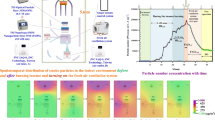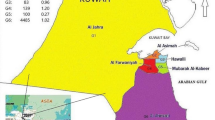Abstract
Despite being a recognized health hazard, burning incense remains in widespread use. A number of studies have investigated the emissions of air pollulants from incense burning, but less attention has been given to particle decay following incense burning. We have studied the elemental composition and indoor emission characteristics of incense sticks in terms of the size distribution and concentrations of fine particles. The results of chemical analysis and energy dispersive X-ray spectroscopy showed that the primary constituents of the emissions were CaCO3 and SiO2, together with lesser amounts of Mg, K, Al, Fe, and Cl. Analysis using a scanning mobility particle sizer revealed that the maximum total particle concentration at the end of the burning period was up to 30-fold higher than that of the initial background levels and that it remained elevated even 100 min after the incense sticks had been completely burned up. Emitted incense particles decayed in a biexponential manner, with particles of up to 100 nm in size decaying with lifetimes of several tens of minutes, while nanoparticles with diameters of 100–700 nm having lifetimes of > 100 min, as their removal mechanisms are slower. The peak particle size immediately following the end of incense burning was 85 nm, and this increased to 110 nm at 100 min after completion of burning. This result indicates that a high proportion of emitted particles can be inhaled into the alveolar region of the lung, where the potential for adverse health effects is the greatest. These findings provide a more detailed insight into particle decay mechanisms under conditions of low ventilation, with implications for human health.









Similar content being viewed by others
References
Bootdee S, Chantara S, Prapamontol T (2016) Determination of PM 2.5 and polycyclic aromatic hydrocarbons from incense burning emission at shrine for health risk assessment. Atmosph Poll Res 7:680–689
Brown JS, Zeman KL, Bennett WD (2002) Ultrafine particle deposition and clearance in the healthy and obstructed lung. Am J Respir Crit Care Med 166:1240–1247
Chang Y-C, Lee H-W, Tseng H-H (2007) The formation of incense smoke. J Aerosol Sci 38:39–51
Chen L-Y, Ho C (2016) Incense burning during pregnancy and birth weight and head circumference among term births. Taiwan Birth Cohort Stud Environ Health Perspect 124:1487
Chen Y, Ho W, Yu Y (2017) Adolescent lung function associated with incense burning and other environmental exposures at home. Indoor Air 27:746–752
Cheng Y, Bechtold W, Yu C, Hung I (1995) Incense smoke: characterization and dynamics in indoor environments. Aerosol Sci Technol 23:271–281
Chuang H-C, Jones TP, Lung S-CC, BéruBé KA (2011) Soot-driven reactive oxygen species formation from incense burning. Sci Total Environ 409:4781–4787
Chuang H-C, BéruBé K, Lung S-CC, Bai K-J, Jones T (2013) Investigation into the oxidative potential generated by the formation of particulate matter from incense combustion. J Hazard Mater 244:142–150
Cohen R, Sexton KG, Yeatts KB (2013) Hazard assessment of United Arab Emirates (UAE) incense smoke. Sci Total Environ 458:176–186
Fang G-C, Chang C-N, Chu C-C, Wu Y-S, Fu PP-C, Chang S-C, Yang I-L (2003) Fine (PM 2.5), coarse (PM 2.5–10), and metallic elements of suspended particulates for incense burning at Tzu Yun yen temple in central. Taiwan Chemosph 51:983–991
Hayakawa R, Matsunaga K, Arima Y (1987) Depigmented contact dermatitis due to incense. Contact Dermatitis 16:272–274
Hinds WC (2012) Aerosol technology: properties, behavior, and measurement of airborne particles. Wiley, Hoboken
Ho SSH, Yu JZ (2002) Concentrations of formaldehyde and other carbonyls in environments affected by incense burning. J Environ Monit 4:728–733
European Commission (2015) Environment: Air Quality Standards [22.01.2015; 10.02.2015]. http://ec.europa.eu/environment/air/quality/standards.html
Huynh C, Savolainen H, Vu-Duc T, Guillemin M, Iselin F (1991) Impact of thermal proofing of a church on its indoor air quality: the combustion of candles and incense as a source of pollution. Sci Total Environ 102:241–251
Jetter JJ, Guo Z, McBrian JA, Flynn MR (2002) Characterization of emissions from burning incense. Sci Total Environ 295:51–67
Ji X, Le Bihan O, Ramalho O et al (2010) Characterization of particles emitted by incense burning in an experimental house. Indoor Air 20:147–158
Kuo S-C, Tsai YI (2017) Emission characteristics of allergenic terpenols in PM 2.5 released from incense burning and the effect of light on the emissions. Sci Total Environ 584:495–504
Kuo S-C, Tsai YI, Sopajaree K (2016) Emission characteristics of carboxylates in PM 2.5 from incense burning with the effect of light on acetate. Atmos Environ 138:125–134
Lagzi I, Mészáros R, Gelybó G, Leelőssy Á (2013) Atmospheric chemistry. Eötvös Loránd University, Budapest
Lee S-C, Wang B (2004) Characteristics of emissions of air pollutants from burning of incense in a large environmental chamber. Atmos Environ 38:941–951
Lewinski N, Zhu H, Drezek R (2009) Evaluating strategies for risk assessment of nanomaterials nanotoxicity: from in vivo and in vitro models to health risks. Wiley, Chichester, pp 459–498
Lin T-C, Yang C-R, Chang F-H (2007) Burning characteristics and emission products related to metallic content in incense. J Hazard Mater 140:165–172
Löfroth G, Stensman C, Brandhorst-Satzkorn M (1991) Indoor sources of mutagenic aerosol particulate matter: smoking, cooking and incense burning. Mutat Res/Genet Toxicol 261:21–28
Lui K, Bandowe BAM, Ho SSH et al (2016) Characterization of chemical components and bioreactivity of fine particulate matter (PM 2.5) during incense burning. Environ Pollut 213:524–532
Lung SC, Kao MC, Hu SC (2003) Contribution of incense burning to indoor PM10 and particle‐bound polycyclic aromatic hydrocarbons under two ventilation conditions. Indoor Air 13:194–199
Mannix RC, Nguyen KP, Tan EW, Ho EE, Phalen RF (1996) Physical characterization of incense aerosols. Sci Total Environ 193:149–158
Navasumrit P, Arayasiri M, Hiang OMT et al (2008) Potential health effects of exposure to carcinogenic compounds in incense smoke in temple workers. Chem Biol Interact 173:19–31
Nazaroff WW (2004) Indoor particle dynamics. Indoor Air 14:175–183
Nel A, Xia T, Mädler L, Li N (2006) Toxic potential of materials at the nanolevel. Science 311:622–627
Ott WR, Siegmann HC (2006) Using multiple continuous fine particle monitors to characterize tobacco, incense, candle, cooking, wood burning, and vehicular sources in indoor, outdoor, and in-transit settings. Atmos Environ 40:821–843
Remškar M, Tavčar G, Škapin SD (2015) Sparklers as a nanohazard: size distribution measurements of the nanoparticles released from sparklers. Air Qual Atmos Health 8:205–211
Rim D, Green M, Wallace L, Persily A, Choi J-I (2012) Evolution of ultrafine particle size distributions following indoor episodic releases: relative importance of coagulation, deposition and ventilation. Aerosol Sci Technol 46:494–503
See S, Balasubramanian R (2011) Characterization of fine particle emissions from incense burning. Build Environ 46:1074–1080
See SW, Balasubramanian R, Joshi UM (2007) Physical characteristics of nanoparticles emitted from incense smoke. Sci Technol Adv Mater 8:25–32
Song X, Ma W, Xu X et al (2017) The Association of Domestic Incense Burning with hypertension and blood pressure in Guangdong. Chi Int J Environ Res Publ Health 14:788
Stabile L, Fuoco F, Buonanno G (2012) Characteristics of particles and black carbon emitted by combustion of incenses, candles and anti-mosquito products. Build Environ 56:184–191
Vance ME, Marr LC (2015) Exposure to airborne engineered nanoparticles in the indoor environment. Atmos Environ 106:503–509
Vu TV, Ondracek J, Zdímal V, Schwarz J, Delgado-Saborit JM, Harrison RM (2017) Physical properties and lung deposition of particles emitted from five major indoor sources. Air Qual Atmos Health 10:1–14
Wang B, Lee S, Ho K (2006) Chemical composition of fine particles from incense burning in a large environmental chamber. Atmos Environ 40:7858–7868
Yang C-R, Lin T-C, Chang F-H (2006) Correlation between calcium carbonate content and emission characteristics of incense. J Air Waste Manage Assoc 56:1726–1732
Yang C-R, Lin T-C, Chang F-H (2007) Particle size distribution and PAH concentrations of incense smoke in a combustion chamber. Environ Pollut 145:606–615
Zhang Z, Chen Q (2006) Experimental measurements and numerical simulations of particle transport and distribution in ventilated rooms. Atmos Environ 40:3396–3408
Zhou R, An Q, Pan X, Yang B, Hu J, Wang Y (2015) Higher cytotoxicity and genotoxicity of burning incense than cigarette. Environ Chem Lett 13:465–471
Zhou Y, Deng Y, Wu P, Cao S-J (2017) The effects of ventilation and floor heating systems on the dispersion and deposition of fine particles in an enclosed environment. Build Environ 125:192–205
Zhuang C, Yang G, Long T, Hu D (2017) Numerical comparison of removal and deposition for fully-distributed particles in central-and split-type air-conditioning rooms. Build Environ 112:17–28
Acknowledgements
This work has been partly financed and supported by the ISO-FOOD Project “ERA Chair for Isotope Techniques in Food Quality, Safety and Traceability” (grant agreement No. 621329) and Slovenian Research Agency, contract P1-0099. BV thanks Miri Trainic (Weizmann Institute of Science) for useful discussions.
Author information
Authors and Affiliations
Corresponding author
Ethics declarations
Conflict of interest
The authors declare that they have no conflict of interest.
Electronic supplementary material
ESM 1
(DOCX 8651 kb)
Rights and permissions
About this article
Cite this article
Višić, B., Kranjc, E., Pirker, L. et al. Incense powder and particle emission characteristics during and after burning incense in an unventilated room setting. Air Qual Atmos Health 11, 649–663 (2018). https://doi.org/10.1007/s11869-018-0572-6
Received:
Accepted:
Published:
Issue Date:
DOI: https://doi.org/10.1007/s11869-018-0572-6




